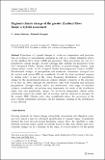| dc.contributor.author | Strzepek, Kenneth Marc | |
| dc.contributor.author | Schlosser, Adam | |
| dc.date.accessioned | 2016-06-30T17:10:33Z | |
| dc.date.available | 2016-06-30T17:10:33Z | |
| dc.date.issued | 2014-09 | |
| dc.date.submitted | 2013-06 | |
| dc.identifier.issn | 0165-0009 | |
| dc.identifier.issn | 1573-1480 | |
| dc.identifier.uri | http://hdl.handle.net/1721.1/103388 | |
| dc.description.abstract | Projections of regional changes in surface-air temperature and precipitation, in response to unconstrained emissions as well as a climate mitigation policy, for the Zambezi River Basin (ZRB) are presented. These projections are cast in a probabilistic context through a hybrid technique that combines the projections of the MIT Integrated Global System Model (IGSM) to pattern-change kernels from climate-model results of the Coupled Model Intercomparison Project (CMIP). Distributional changes of precipitation and surface-air temperature averaged over the western and eastern ZRB are considered. Overall, the most significant response to climate policy is seen in the spring. Frequency distributions of precipitation change for the unconstrained emission scenario indicate a majority of the outcomes to be drier by 2050, although the distribution spans both increased and decreased precipitation. Through climate policy, the distributions’ total range of outcomes collapses considerably, and perhaps more importantly, the mode of the distribution aligns with zero precipitation change. For surface-air temperature, climate policy consistently reduces the modal value of warming, and this reduction is strongest for the western ZRB. Climate policy also considerably abates the occurrence of the most extreme temperature increases, but the minimum warming in the distributions is less affected. | en_US |
| dc.description.sponsorship | United Nations University. World Institute for Development Economics Research | en_US |
| dc.description.sponsorship | Massachusetts Institute of Technology. Joint Program on the Science & Policy of Global Change | en_US |
| dc.publisher | Springer Netherlands | en_US |
| dc.relation.isversionof | http://dx.doi.org/10.1007/s10584-014-1230-0 | en_US |
| dc.rights | Creative Commons Attribution | en_US |
| dc.rights.uri | http://creativecommons.org/licenses/by/4.0/ | en_US |
| dc.source | Springer Netherlands | en_US |
| dc.title | Regional climate change of the greater Zambezi River Basin: a hybrid assessment | en_US |
| dc.type | Article | en_US |
| dc.identifier.citation | Schlosser, C. Adam, and Kenneth Strzepek. “Regional Climate Change of the Greater Zambezi River Basin: A Hybrid Assessment.” Climatic Change 130.1 (2015): 9–19. | en_US |
| dc.contributor.department | Massachusetts Institute of Technology. Center for Global Change Science | en_US |
| dc.contributor.department | Massachusetts Institute of Technology. Joint Program on the Science & Policy of Global Change | en_US |
| dc.contributor.mitauthor | Strzepek, Kenneth Marc | en_US |
| dc.contributor.mitauthor | Schlosser, Adam | en_US |
| dc.relation.journal | Climatic Change | en_US |
| dc.eprint.version | Final published version | en_US |
| dc.type.uri | http://purl.org/eprint/type/JournalArticle | en_US |
| eprint.status | http://purl.org/eprint/status/PeerReviewed | en_US |
| dc.date.updated | 2016-05-23T09:35:57Z | |
| dc.language.rfc3066 | en | |
| dc.rights.holder | UNU-WIDER | |
| dspace.orderedauthors | Schlosser, C. Adam; Strzepek, Kenneth | en_US |
| dspace.embargo.terms | N | en_US |
| mit.license | PUBLISHER_CC | en_US |
